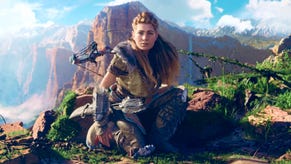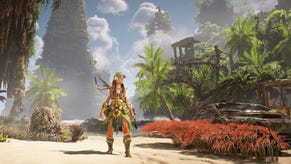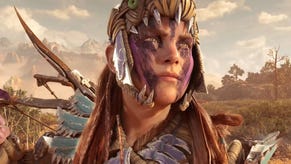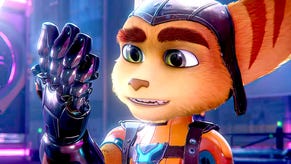Can Horizon: Zero Dawn really be a AAA game without cynicism?
The human side of robot dinosaurs.
Up until last week, I didn't have a very clear handle on what sort of game Horizon: Zero Dawn was. It was the one with the robot dinosaurs, that much I knew, but details of how it actually played still seemed somewhat murky. It also seemed massively ambitious, given that its Amsterdam-based developer Guerrilla Games is best known for linear first person shooter franchise Killzone. It wasn't the first studio I'd have in mind to tackle a project like Horizon, given that the two properties were like night and day, with Horizon an open-world action RPG set in a vivacious post-apocalyptic world where nature - and those aforementioned robots - have reclaimed earth.
"Every other month we had a moment where we felt we were trying too much," Guerilla's managing director Hermen Hulst tells me. "Moments where [we doubted] the amount of newness to the team, the size of the world, the fact that it's a different genre; we had gaps in our team that we had to fill with experts in the genre. There's so much new stuff, so much imagination that was needed to set up this new IP. Open-world is completely different, and I know there are studios with a ton of experience with that, but we needed to obtain all the experience on this project. It's [about] learning as you go."
The interesting thing about talking to the different departments of Horizon's design team is that you get the sense that the company had to come up with new philosophies, new ideas and new ways of thinking, and that, to a person, they were all very much up for the challenge. That said, as Hulst puts it, they still had plenty of knowledge to draw from within their existing talent pool. "We hired in new expertise, exposed the great talent that we already had, and also really learned from everything that we gained on the Killzone series. They're different, but it's still a science-fiction universe, so the design processes are similar. The combat was very tactical, always. We stand on the shoulders of all our learnings from the Killzone series."
Combat was one thing, as the Killzone series proves that Guerrilla has always known how to craft impactful, meaty weapons. What is more impressive is how all the other mechanics - the skill trees, the resource management, the looting, the trapping, the crafting, the dialogue wheels, the side quests - all come together to form a cohesive whole. The problem is, games that profess to do everything can often promise way too much pre-release and then under-deliver - particularly if they come from a first-party studio where the stakes are high and the anticipation even more so.
"For Horizon, the ambition has been massive," Hulst acknowledges, "and at the same time we've tried to craft a vision that we can digest, and that goes to 'how big do you make the map? What density of content is required to make it challenging but not too full? What is the golden path of the central narrative?' We try to be very realistic about it.
"And don't forget, we have done games in two years before. We've also done games in five years, so we do, as a studio, have a lot of experience with scoping, even though the challenges themselves can be new to us. The production management of it, and how that relates to the game directional challenges that you set for the team, is a craft, at the end of the day; it's a craft that you need to master. I'm very pleased with how all of these challenges have panned out for our game."

One thing that is immediately obvious right from Horizon's opening scenes is the emphasis placed squarely on storytelling. John Gonzalez, lead writer on Fallout: New Vegas and lead narrative designer on Shadow of Mordor, is among the new blood drafted in to Guerrilla to lead Horizon's storytelling in bold new directions for the studio. "I've been in this industry a while, and I've seen a lot of things that might make you feel cynical about it," Gonzalez says. "One of the things about this game and this concept, one of the reasons I really wanted to come and work here, was that there was no cynicism, and certainly no reluctance at all to pursue having a strong female character who is fundamentally human. That's why I think she's a good character; she's a human being."
I certainly warmed to Horizon's hero Aloy more than I thought I would during the few hours I was able to go hands-on with the game. It doesn't hurt that she's voiced by Ashly Burch, who also provides the voice of Chloe Price in Life is Strange and Tiny Tina in Borderlands. But there's also a humanity to Aloy that transcends the potentially dull Strong Female Character archetype, which I like. It also helps that the game isn't peppered with made-up words and references to fictionalised cultures, a decision that Gonzalez says is deliberate; "We tried to be careful about making a game that felt like reading a dictionary." As a result, characters talk as we would, not in an approximation of how primitive dialects might sound. That's especially welcome when it comes to the dialogue wheels, which act less like a black-and-white morality system for players to 'gamify', and more like an emotional window through which players can interpret and express how they see Aloy responding to a situation.
It remains to be seen how the narrative will develop over the course of the game, but early impressions indicate that Horizon's storytelling is surprisingly confident, up to and including a Rocky-style training montage that, despite its oddness, works. It's harder to get the measure of how gameplay will evolve over Horizon's running time, particularly given the relative complexity of how the various systems are interwoven. What does seem clear, however, is that players shouldn't go into Horizon expecting an experience like Monster Hunter, where hunts must be meticulously planned out in advance. Different creatures will require players to think strategically when it comes to the various tools at their disposal, and robots present enough of a challenge that it remains unwise to run directly into battles without at least considering what traps and tripwires you can lay down first. But it's more on par with the combat of The Witcher, in that you can muddle through with a spear and a slack handful of arrows, if that's how you prefer to live your life. It's just as well, as often when wandering around the open map from one point of interest to another, it's easy to accidentally trigger a herd into a stand-off situation.

The robots are undeniably the stars of the show here, and each of the 25 designs has been painstakingly created, as Guerrilla is keen to show off to us in an extensive studio tour that takes us all the way through a robot's conception to its implementation in the game. The design teams were adamant that robots be built so that they could conceivably be functional, a process that studio art director Jan-Bart Van Beek jokingly branded "annoyingly, painstakingly, idiotically methodical." Inspirations for each robot's form and function are taken from engineering - the lead concept artist is a Guerrilla veteran and telecommunication engineer who specialised in vehicle and mechanical design for Killzone - and from the animal kingdom: one robot we were shown was inspired by mosquitoes for function, anteaters, frogs and pelicans for form, and kangaroos and emus for movement.
It's easy to see how having every design idea rooted in practical functionality helps the different departments in development create a more unified vision of how each creature works. In game, of course, you think about all of this for roughly the same amount of time it takes to notch another arrow to Aloy's compound bow, but it does mean each robot has a very distinct personality and, more importantly, presents a unique challenge to overcome. These challenges are enjoyable enough that you will be tempted to seek them out in the early stages of the game in order to farm new resources for your ammo and outfit crafting, but it's hard to say whether that grind will remain as enticing once you have a few hours of gameplay under your belt.
During my hands-on session, I played the first three main missions of the campaign, with a few side quests thrown in, before skipping ahead in the story (apparently to avoid spoilers) and being let loose on the open world to explore some of the Nora homelands. It's never an ideal way to get a feel for the rhythm of an open-world RPG, but it was just enough to get an idea of the story that Guerilla is trying to tell with Aloy - a story that is surprisingly compelling, despite the fact that many fans feel they've already got the main narrative beats pegged a mile off.
It's difficult to get a sense of how deep the various systems go - and, in the end, the execution of these is what a game like this lives or dies on. Early impressions are encouraging, however. There's something innately satisfying about trawling the wilderness, tools in hand, and surviving, and then thriving. On paper there's nothing hugely new here; fragments of games like Mass Effect, the rebooted Tomb Raider, Assassin's Creed, The Witcher 3 and Far Cry Primal spring to mind. But Horizon does seem to deliver them in a voice that is uniquely its own. Plus, robot dinosaurs are just cool, aren't they?









